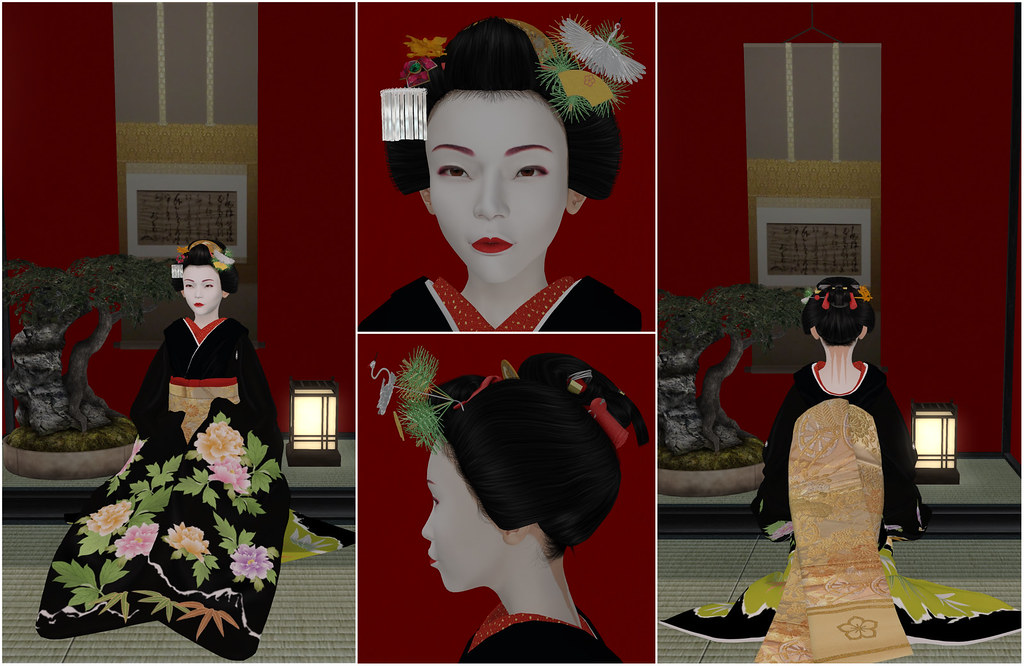#ofuku hairstyle
Text
Hey bestie congrats on getting fucked! It was kinda cringe seeing you walk the streets wearing the virgin little-girl hairstyle 😬👎... But now I see you with the ofuku so I know 😏😏😉


#bookposting#geisha and maiko hairstyles#and what they used to mean#guess I should tag mizuage and ofuku here too
1 note
·
View note
Note
hii!! i was wondering just now how did mizuage work? everybody talks about it but nobody knows how it was done, i heard some rumors that the hairstyle momoware was connected and ofuku? how did it happen? it's all really confusing!! ty ^^
Hey! Tbh apart from rumours, the only source I have about this topic is Kiharu Nakamura's biography. The word "Mizuage" isn't in the book, but there's an entire chapter dedicated to "deflowering" (literally). So I guess it's about Mizuage? For a chronological placement - this happened in the 1930's, in Tokyo-Shinbashi. Not some shady brothel district.
According to Kiharu's Okasan: for becoming a famous Geisha, it is important who you were deflowered by. Only a minister or a major industrial comes into question. That guy might even become a sponsor in future! And if he doesn't, at least the respective Geisha could boast with "this important guy deflowered me".
Kiharu talks about that one day, she attended an Ozashiki, where a specific minister with "a grotesque face, as old as my own grandfather" attended. The guy who was willing to do the deed. After some time, he vanished and she was called into a backroom of the Ochaya by the housekeeper of her Okiya. The minister waited there, the housekeeper wished "well then... have fun" and vanished. According to Kiharu, she was able to coax the minister into leaving her in peace.
It also reads like Kiharu had passed Hangyoku stage at that point and was free of debt, so I doubt it has any meaning of "this girl has passed an important step in her training". So, yeah. It was just for prestige. And probably bringing in some extra money.
Source: Kiharu Nakamura "Memoiren einer Geisha", 1997, p. 50-57.
9 notes
·
View notes
Note
hi! I saw kamishichiken new year's greeting photos for this year and i noticed that ichiyuu hasn't changed her hairstyle to ofuku yet even though its been around 3 months since she entered her 3rd year, do you know whats the reason for that? thanks!
Three months into her third year means that she just completed her second year, so there's no need to rush. I won't expect her to be in ofuku until at least the Kitano Odori in March as most maiko don't switch until they've completed at least two and a half years of service ^^
6 notes
·
View notes
Text

May 2019: Maiko Kanako (Kawahisa Okiya) of Miyagawacho throwing the first pitch during a baseball game at the Koshei Stadium.
It’s a tradition for a Maiko or Geiko from Miyagawacho to throw the first pitch during a Hanshin Tigers baseball game once a year! Last year, now retired Geiko Kimihiro was chosen to do it.
Don’t get confused by Kanako’s kanzashi by the way: She’s wearing her January kanzashi because it features lucky motifs and a small Hanshin Tigers flag is pinned to it!
Baseball is one of the most popular sports in Japan, alongside Sumo, Judo and soccer. They have a unique tradition when it comes to throwing first pitches: The batter is supposed to swing and miss the ball on purpose!
Source: Spoon & Tamago on Instagram
#kanako#kawahisa okiya#miyagawacho#kimono#hikizuri#furisode#susohiki#obi#darari obi#obiage#obijime#obidome#oshiroi#makeup#ofuku hairstyle#ofuku#hairstyle#hair#kanzashi#daikin#hairpin#hair ornament#comb#kushi#geisha#maiko#geigi#geiko#nihongami#geisha makeup
688 notes
·
View notes
Photo

Maiko Nihongami 101: The Ofuku (おふく)
The second hairstyle a maiko wears in her apprenticeship is the Ofuku (おふく). From the front, the senior maiko Ofuku is very similar visually to the junior maiko Wareshinobu. However, the back of the hairstyle is different. Instead of the large circular red fabric cushion (the Arimachi Kanoko (ありまち鹿の子)) that prominently displays the Mage (髷) aka the bun of hair on the back of the Wareshinobu, the Ofuku lacks any cushions or supports. The bun goes from circular and raised to a subdued, naturally volumed half moon shape. Additionally, instead of the flashy, bejeweled, valuable Kanokodome (鹿の子留め) pin stuck in the center of the of the Wareshinobu mage, the Ofuku is simply decorated with a triangular piece of cloth called the Tegara (手柄). Tegara come in many different patterns done in silver, gold, black, or even other colors- the design on the Tegara fabric is up to individual Maiko and Okamisans. However, the base color of the Tegara fabric is codeified. Upon being promoted to senior status and changing over to the Ofuku hairstyle, a maiko will wear a red Tegara initially. Over the course of 6-12 months, she will change to a pink Tegara. Finally, as the closing years of her apprenticeship pass, Tegara with base colors like blue, green, orange, lavender, yellow, and more will appear.
While the Wareshinobu and the Ofuku hairstyles are the standard hairstyles for junior and senior maiko respectively, there are numerous other hairstyles worn for special occasions like Setsubun and Gion Matsuri.
Tune in for the next episode of Maiko Nihongami 101:
The Katsuyama (勝山) hairstyle!
#geisha#maiko#nihongami#ofuku#ofuku hairstyle#japan#hairstyles#hair#hairstyle#japanese traditional hairstyles#kyoto#geimaiko#karyukai#maiko nihongami 101
117 notes
·
View notes
Photo
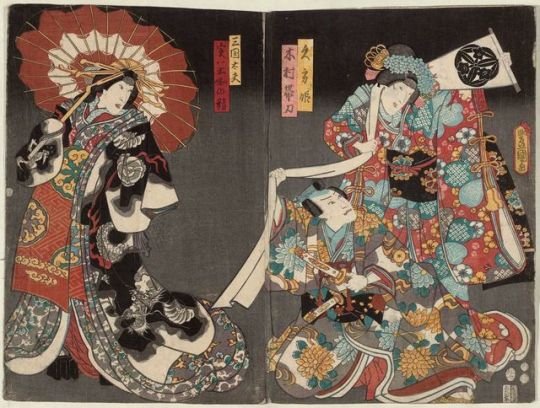
“Actors Iwai Kumesaburô III as Hisakata Hime and Arashi Kichisaburô III as Kimura Tatewaki (R), and Nakamura Tomijûrô II as Sangoku no Tayû, Actually the Spirit of a Spider (L)“ by Utagawa Kunisada, Edo period, 1853.
29 notes
·
View notes
Photo

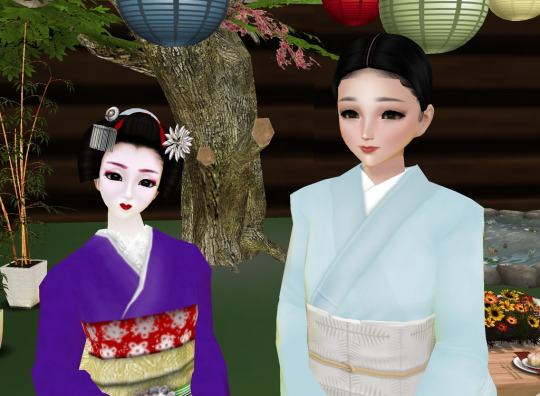
A maiko’s career has plenty of milestones, but one of the more important ones is the wagekae - the change into ofuku hairstyle, when one becomes a senior maiko, which was our reason to celebrate: in August 2021 we celebrated the wagekae of maiko Mitsuyo!
4 notes
·
View notes
Photo

September 2019: Aoi-tayuu, of Suehiro okiya, having her hair done in the Kottai Ofuku hairstyle onstage as part of a charity event to commemorate the 2018 Hokkaido Eastern Iburi earthquake.
Source: https://twitter.com/ayaka8700119/status/1177498162891636736?s=20
#kimono#tayuu#tayu#aoi#aoitayu#aoitayuu#suehiro#suehirotayuu#suehirotayu#suehirotimeline#suehirookiya#suehiro2019#shimabara#shimabaratayu#shimabaratayuu#nihongami#yuujonihongami#yuujo#yuukaku#yuukakunihongami#kottai#kottaiofuku
20 notes
·
View notes
Photo
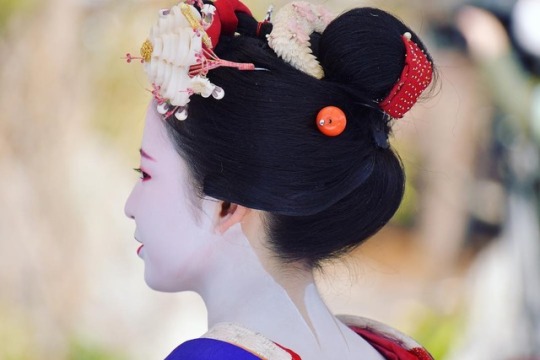
Maiko Umehina’s delicate ofuku hairstyle
(SOURCE)
77 notes
·
View notes
Text
Maiko – Apprentice Geisha
Maiko are apprentice geisha (geiko). They are only found in Kyoto and are often used as the ultimate symbol of Japan. Maiko are a rare breed now, only several at any one time and confined primarily to the Gion and Pontocho districts.
Maiko are easily recognised by their attire. In the Japanese way, as young girls before they become women, the dress of the Maiko is more outlandish than that of the mature Geisha. The Obi and Kimono of a Maiko is brightly coloured and ornately decorated, the Kimono is of the Furisode style (more specifically of the oburisode type kimono) with long flapping sleeves that fall to the floor. The collar of the under-kimono worn by the Maiko is usually of a red and white patterned material, and shows vividly against the white neck of the Maiko.
Maiko move through several stages of maturity as their apprenticeship continues. Numerous highly ritual costume changes are made to identify these passages of time. Maiko have several different hair styles, makeup complexity changes and the pattern of the collar moves from colourful to demure and white. These changes are physical indicators of the maturity of the girl moving from flighty and girlish to demure and womanly.
A first-year maiko continues to only paint her bottom lip, and she wears long, dangling shidare kanzashi. Her collar is predominantly red with small patches of white embroidery, and her hikizuri kimono usually has a busy pattern. Once she finishes her 1st year of apprenticeship she will begin painting her upper lip, and stop wearing shidare kanzashi. Tomitae of Gion Higashi as junior maiko.
A maiko becomes a senior when her okaasan thinks she has earned it through her dancing and musical accomplishments, usually around the 3rd year of apprenticeship. At this point her eri will be completely embroidered so it is white, and her hairstyle changes to ofuku. Over the next year or two the colour of the tegarafolded cloth in her hairstyle will change to show her seniority. Tomitae of Gion Higashi as senior maiko.
The Obi of a Maiko is longer than any other traditional kimono obi and tied in an ornate style rather than the box knots common in the Obi of both Geisha and other Japanese women. The Obi is tied very high on a Maiko, coming high into the arm pit, with the knot reaching almost to the collar and the ends falling to the floor. Maiko also wear distinctive Okobo, large platformed wooden shoes, which taper to a smaller point on the sole, these are often lacquered and ornate. Okobo usually force a young Maiko to take very small steps, which is considered attractive by Japanese tradition.
Maiko use their own hair for their elaborate traditional hair styles rather than the wigs that contemporary Geisha wear. Traditionally it is a sign of a productive and hard apprenticeships to have a small bald patch from the ornate hair styles but as apprenticeships grow shorter and wigs more common this is a fading sign of a retired Geisha. The hair ornaments for a Maiko are plentiful and extravagant and are matched to the current season, usually displaying a fall of seasonal flowers constructed from beads.
Two to three months before her erikae (graduation), a maiko will begin tying her obiage and tucking it behind her obi. A month before her erikae she will wear a special hairstyle dependent on which district she is from; In Gion Kobu she would wear yakko shimada, but in Pontocho she could wear any of around 5 different hairstyles. Tomitae of Gion Higashi with yakko shimada
Two weeks before erikae a maiko will wear sakkou hairstyle, with its accompanying outfit and ohaguro (blackened teeth) if she chooses. The outfit worn depends on which kagai she is from:
In Gion Kobu maiko wear kuromontsuki hikizuri, white eri, gold obi, and a special sakkou kanzashi.
In Gion Higashi maiko wear busily-patterned hikizuri, a gold-flecked red eri, a gold obi, and special sakkou kanzashi.
In Miyagawacho maiko wear kuromontsuki hikizuri, a gold-flecked red eri, gold obi, and a special sakkou kanzashi. Sometimes, instead of wearing kuromontsuki hikizuri, a maiko will wear an iromontsuki hikizuri of deep blue, brown or light blue.
In Pontocho maiko wear iromontsuki hikizuri of bla bold colour like blue or brown, with a gold-flecked red eri, gold obi, and a special sakkou kanzashi.
In Kamishichiken maiko wear iromontsuki hikizuri of brown, blue or pale pink, with a gold-flecked red eri, gold obi, and a special sakkou kanzashi. Sometimes, instead of wearing iromontsuki hikizuri, she will wear kuromontsuki hikizuri.
Erikae, “collar-turning”, is the graduation of apprentice to geiko, professional artisan. At this time the colour of her collar will change to a more demure white as in married women. Her elaborate sakkou hairstyle is undone and the top piece cut off so she can wear her custom-made katsura wig. She dresses in tomesode hikizuri kimono with shorter sleeves indicating her growing maturity.
While beautiful to look at Maiko are still young girls, so the social mastery they are expected to attain as accomplished Geisha is still not fully formed and Maiko are usually expected to dance, and be seen, and though performing tasks such as filling drinks they are not intended to entertain guests to the same degree as a Geisha. Young girls may become Maiko at 16, under current Japanese law, as all adolescents must attend high school to this age. A Maiko’s apprenticeship is usually 5 years, and so at 21 she may become a fully fledged Geisha.
Though not attending conventional school after becoming Maiko, they must nonetheless attend classes every morning in dance, Shamisen, singing and other art. Maiko as well as learning artistic pursuits must learn the social graces and old style Kyoto dialect before becoming a Geisha.
As such an identifiable icon of Japanese traditional culture the Maiko are often in demand, especially for photography. A popular tourist activity in Kyoto is to catch a photograph of a Maiko hurrying to an appointment.
2 notes
·
View notes
Text
What’s That Thing? Part 23
Originally I didn’t plan on this answer being so long, but I initially forgot a bunch of the history, so I thought that it would make for a good lesson if I did it in this format ^^
Anonymous asked:
“Why do vintage Maiko hairstyles looks so much rounder than their modern day counterparts? Is it due to the substances applied to shape them?”
It seems simple enough, but there’s far more than meets the eye when it comes to hair. So, this is going to be answered in two parts as there’s two major factors at play here!
Part 1: The Hairstylists
When the karyukai in Kyoto closed down in 1944 the majority of its residents either left for the countryside where it was safe or were conscripted into factory work. Much of that work was in nearby Osaka, which was bombed during the war. When the karyukai reopened in 1946 many of its former residents did not return, either because they didn’t want to come back to the cities as they wanted to stay where they relocated, or they sadly perished. This wasn’t just about the maiko and geiko themselves, but about everyone who supported them too, including hairstylists. Prior to World War II there were said to have been dozens of hairstylists within Gion Kobu alone, but after the war that number dwindled to only a handful. These women (in most cases) suddenly had a high load of geimaiko who needed their hair styled, but obviously there wasn’t enough time to style all of them like they did prior to the war. This is why geiko began to wear katsura as they only need to be styled once a month by a wig specialist and it left the majority of the appointments for hairstylists open for maiko and regular customers.

Image courtesy of Blue Ruin 1.
Part 2: The Construction
With only a few hairstylists this also meant that maiko couldn’t spend over an hour each time they got their hair styled as that would severely limit how many girls could have their hair styled at any given time. So, new methods were found to make the same styles, but in more efficient ways. Where styles used to only use the maiko’s real hair and the shape of a style could vary for each girl depending on their hair length, extensions and supports gave them all uniform looks that only took a fraction of the time to set. Their real hair was and still is the main focus, but the extensions, which blend in perfectly with their own hair, make their iconic nihongami styles easy to identify and mimic the same structure as the old ways. A perfect example of how hair changed before and after the war is illustrated in the image above. The maiko in the middle and on the right are both wearing ofuku, but the one in the middle was styled with the “old” ways and the one on the right in the “new” ways. In the old version only a maiko’s real hair is used, so how full the mage is or how rounded the bin are depend entirely on her own hair. The tegara in the back is an actual folded cloth that is directly tied and tucked into the back of the hair. On the right we see the new construction, which looks like this up close:
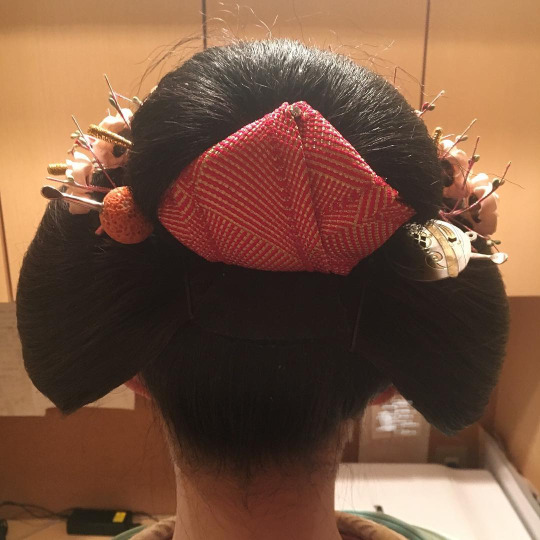
Image courtesy of Higashi Ichi.
The mage is now made with the maiko’s own hair and a hair extension, which provides structure and stability; you can see the base of the extension underneath the tegara. This extension also makes it easier to undo the style when it needs to be reset. Unlike the old tegara, the new ones are pre-folded fabric pieces that tuck in slightly at the bottom and are held in by a pin at the top. Because they’re pre-made they can also feature more intricate decoration and embroidery as their positioning is now controlled.
As for answering the final part of the question about the materials, they haven’t changed at all. A special type of binsuke wax is still used to keep the hair stiff and maiko will still comb in camellia oil to keep it shiny and smelling nice ^^
#maiko#geiko#geisha#kyoto#ask#hair#hairstyling#nihongami#kamiyui#kamigata#ofuku#舞妓#芸妓#芸者#京都#尋ねる#髪#日本髪#髪結#髪型#おふく
118 notes
·
View notes
Text
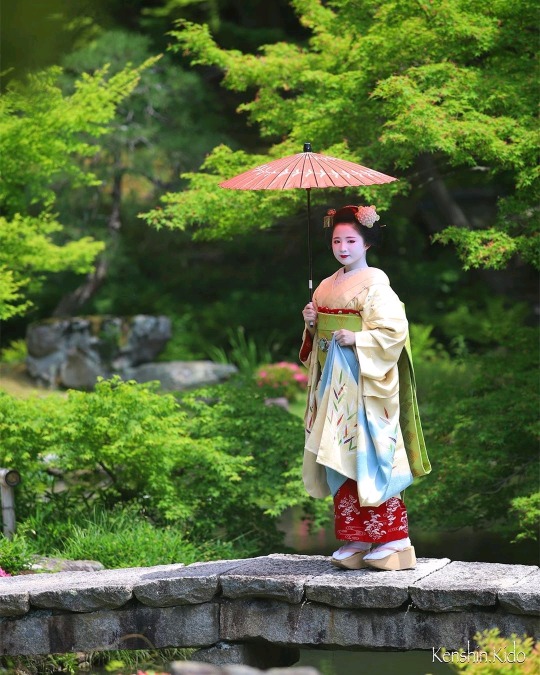
June 2019: Maiko Umehina (Umeno Okiya) of Kamishichiken in the gardens of the Konkaikōmyō-ji Temple in Kyoto.
Source: Masanobu Kido on Instagram
#umehina#umeno okiya#kamishichiken#kimono#hikizuri#furisode#susohiki#obi#darari obi#obiage#obidome#oshiroi#makeup#ofuku hairstyle#ofuku#hairstyle#hair#kanzashi#daikin#maezashi#hairpin#hair ornament#comb#kushi#geisha#maiko#geigi#geiko#okobo#geisha makeup
213 notes
·
View notes
Photo

Maiko Nihongami 101: The Oshun (お俊)
Let's step away from the heat of Gion Matsuri and it's Katsuyama hairstyle and slide into the winter-spring borderline season that is February in Japan. Every February 2nd, 3rd, and 4th is a very special time in Japan: It is beginning of the lunar new year, the last days of winter, the first peeks of spring... It is Setsubun (節分) and it is time to celebrate! The geimaiko of Kyoto perform special dances at local Shinto shrines such as Yasaka Jinja and participate in the ancient tradition of throwing lucky, blessed soybeans into the crowd so that they may drive "demons out and bring fortune in!" for the New Year. Additionally, there are celebrations exclusive to the Hanamachi. Geiko celebrate Obake (お化け) across all three days by dressing up in elaborate costumes and performing skits for their customers. It's something akin to the Karyukai's own Halloween and the costumes originally were supposed to scare and confuse wicked spirits.
But the geiko aren't the only ones having fun. The maiko get in on the festivities by wearing a huge array of hairstyles that are mostly exclusively worn during Setsubun. They also wear unique, special kimono like Edo period style hikizuri with black collars and bold geometric patterns or fantastic tie-dye shibori ensembles as well as festive kanzashi of various kinds.
There are many, many hairstyles worn by maiko during Setsubun but I will cover the main ones. We'll start our journey into Setsubun nihongami with the Oshun (お俊) hairstyle!
Like many styles of nihongami, the Oshun hairstyle has its roots in the infamous yuujo ("遊女" women of pleasure, courtesans and prostitutes) in the legendary pleasure districts of Japan (including but not limited to the Yoshiwara in Edo, Shimabara in Kyoto, and Shinmachi in Osaka). A popular yuujo called Oshun invented the hairstyle and, like so many other aspects of courtesan culture, the female population of Edo period Japan immediately adopted it as popular, stylish fashion.
The Oshun hairstyle is one of the few Setsubun associated hairstyles that is worn outside of the February holidays. In the hanamachi of Pontocho, senior maiko wear the Oshun hairstyle as a sort of transitionary hairstyle between Ofuku and the final hairstyle of a maiko's career, the legendary Sakkou.
The next six hairstyles to be featured on Maiko Nihongami 101 will be Setsubun hairstyles so get ready!
Tune in for the next episode of Maiko Nihongami 101:
The Osome (お染) hairstyle!
64 notes
·
View notes
Video
Maiko Kikune is now wearing Sakkou! by Geiko Kikumaru
Via Flickr:
Amazing news coming from Hanafusa okiya - Maiko Kikune was spotted wearing formal attire and with her hair styled into Sakkou hairstyle. This means that in about a month Hanafusa okiya will have new Geiko. Kikune san's erikae celebrations will take place in beginning of winter and we encourage You to come and witness this extremely rare event in the life of the Second Life Karyukai Now lets have a look at the outfit that Kikune san will wear during her "sakkou" stage: Hair: during this last month as a maiko, a very special Sakkou (also known as saki kogai) hairstyle is worn and that is why this stage if often referred to as "sakkou". Before it was adopted by Karyukai, it was worn by the brides-to-be during the Edo era and it signified a dedication for a future husband. Nowadays, by wearing sakkou geiko-to-be shows her dedication for the profession and willingness to continue as part of the Karyukai. As you can see, from the front it does remind a normal Maiko hairstyle(such as ofuku or wareshinobu) but if you look at the back you will notice how extravagant this hairstyle really is - elegant and smooth lines of hair, decorated with silver wires and red bands. Truly, a masterpiece! Kanzashi: specially ordered custom made daikan kanzashi crowns the hair of Maiko Kikune - it features crane flying upon a pine and a bekou fan that has Hanafusa mon (crest). all of these elements are considered lucky and are to bring good fortune. 2 bekkou hairpins and kushi were gifted to her by her oneesan Geiko Kikutsuru Make up: Formal make up with three lines at the back is worn and you can notice that there is more black and almost none pink, meaning she is now a mature lady Eri(collar): with formal sakkou looks also comes special eri that has red background with beautiful golden embroidery(small golden dots) Kimono and obi: as Sakkou stage is considered a highly formal occasion, Kikune san will be wearing most ceremonial, custom made black kuromontsuki that has 5 Hanafusa crests on it. This masterpiece features peonies. Peony (Botan) is known as the 'King of the Flowers' and symbolizes good fortune (wealth), high honour (nobility) and ageless beauty. It is tied golden obi that has noble cart motif
1 note
·
View note
Photo

November 2017: senior maiko Mamesumi with ofuku hairstyle by mirajyu7 on Instagram
New blog is up! Visit HERE 🌟 🌟 🌟
༼ つ ◕◡◕ ༽つ Geisha-kai on P a t r e o n || Instagram
134 notes
·
View notes
Photo

November 2017: maiko Fumiyuki and Ichikoma dancing together at an ozashiki (source). If you look closely, you’ll see that Ichikoma is wearing the ofuku hairstyle and has become a senior maiko! Congratulations Ichikoma!
45 notes
·
View notes
